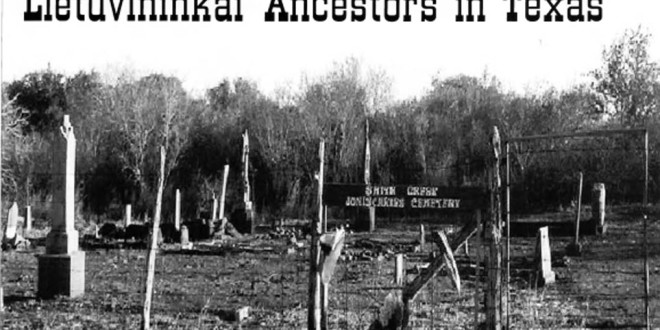By Liuda Žiaugra
On the Trail of Our Lietuvininkai Ancestors in Texas
IT IS ALMOST A DECADE SINCE WE FIRST BEGAN TO find items in the Lithuanian American press about Lithuanians emigrating from Lithuania Minor to Texas some 150 years ago. At that time and in subsequent articles in the Lithuanian daily Draugas, Petras Petrutis of Chicago informed us about this new and quite interesting historical fact. Around 2002, anthropologist Vytis Ciubrinskas and other researchers from Lithuania turned their attention to the mid-19th century source material that supported this officially accepted revised version of history. It was now recognized that the first wave of Lithuanian immigrants to this country was not the one that settled in Pennsylvania to work in the coal mines, but, rather, it was a group of Lietuvininkai who emigrated from Lithuania Minor to South Texas during 1848-1864, before the U.S. Civil War. Earlier this year, in the 16 Feb. 2008 issue of Draugas, Petrutis in his article “Chicago, Yorktown, Boston, Klaipėda” recapped the course of events and the research done to date, mentioning that Bostonian “Jonas Liman tas has also become interested in the Lietuvininkai who settled in Texas […] Limantas now has had a chance to meet face to face with the descendants of the Lietuvininkai who live in Texas.”
As one of the four Bostonians who traveled with Liman tas to South Texas in January of 2008, I would like to share my impressions from this extraordinary journey, during which I met so many new people.
Who are we and why did we make this journey?
We might be best described as a group of individuals of Lithuanian descent, from various backgrounds and professions, who are history buffs with an intellectual curiosity and a passion for knowledge about our roots, culture, and native history. Both Jonas Limantas and filmmaker Romas Šležas are themselves from Lithuania Minor and so they were especially eager to learn more about this diaspora of Lietuvininkai. Milda Bakšys Richardson, Ph.D., whose field is the history of architecture and who serves as president of the New England Chapter, Society of Architectural Historians, set down for our group the scholarly guidelines for our research work and documentation. Reda Veitas Limantas photographed and copied source documents, shot around 1,200 pictures, and together with this writer assumed various administrative and technical tasks, as the need arose.
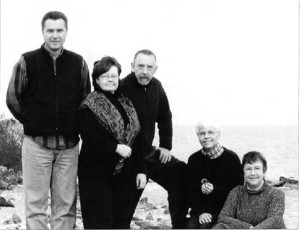
In the spring of 2007, Limantas met in Chicago with Skirmante Miglinas, Director of Archives at the Lithuanian Research and Study Center (LRSC), who gave him access to the material on the descendants of the Lithuanian immigrants to Texas that the center has in its safekeeping. That unique collection was amassed and entrusted to the LRSC by Texan Patsy Hand, who must be given credit for this entire historical find. She took the initial steps to research local records and family roots in the Yorktown-Victoria area and is the tireless spirit and driving force behind this effort. Limantas was struck by the fact that we know so little about the descendants of the Lietuvininkai and concluded that these documents need to be widely disseminated in the Lithuanian press, in Lithuania Minor as well as the U.S. Later in 2007, while traveling in Lithuania, Limantas contacted the History Museum of Lithuania Minor in Klaipėda, which agreed to a joint project – an exhibit and catalogue – to occur during the Commemoration of the Millennium of the Name of Lithuania being celebrated in 2009.
And so we departed for Texas in order to meet the fourth and fifth generation descendants of the Lietuvininkai who live there and to continue the work of collecting source material about the first wave of Lithuanian emigrants to the U.S. At the same time, we had hopes that perhaps we would discover additional records, artifacts, gravestones or monuments. A comprehensive collection of photographs, official documents, identity cards, birth, death and marriage certificates, together with journals and letters, is to be the basis for the joint U.S.-Lithuania project comprising the Lietuvininkai of Texas museum exhibit and catalogue. Also planned is a documentary film that will include individuals sharing personal and family histories passed down through the generations, as well as descriptions of surviving customs and traditions. Another undertaking will be the compilation of an accurate list of families, with the number of family members that emigrated from Lithuania Minor and how many of their descendants remain.
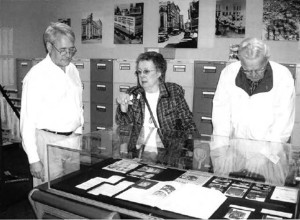
Scenes, roads, and people past and present
Contrary to our expectations of sun and warmth, we were greeted in Houston by an overcast, cloudy sky. We rented a car and three hours later we were in Victoria, which was to be our home base for the next five days. And even though the weather showed us no mercy, whipping us with rain and gusty winds, the warmth of the people, the joy of discovery, and the wide open spaces of Texas outweighed all the discomforts and fatigue of our journey. Bright and early the next morning, Patsy and Glen Hand took us under their wing. Each day began with a set routine and extended late into the evening. We were handed a rather intensive daily schedule with stops at noteworthy places, museums, cemeteries that included meetings with various individuals. Glen patiently drove us around the 500- 600 mile circuit of Victoria-San Antonio-New Braunfels-WeesacheYorktown-Meyersville-Victoria, while Patsy was our group’s superb leader and guiding spirit, telling us about her native state, about its rich past and present, its people, its agriculture, and, of course, about her favorite activity – digging through archives and researching genealogies.
This remarkable woman deserves more than a few words about her. Around thirty years ago, Patsy Hand began to organize her and her husband’s family archives. Having traced her family tree back to her great-great-great-grandparents through documents and photographs, she came up against some very strange-sounding last names and places. Because her parents traditionally had regarded themselves to be of German descent, Patsy was especially eager to learn the national origins of her great-great-great-grandfather’s rather unusual last name of Lundschen and to find on a map of Europe the not very Germansounding place of Akmeniszken, where he was born and raised. Her first attempts began in pre-Internet times, which meant combing through the public records of cities and other localities, writing letters of inquiry, maintaining a detailed and persistent correspondence with specialists and government officials. It would take months, sometimes even years, for her to receive a response of some sort or another.
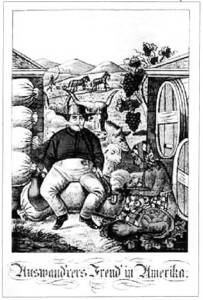
At long last the mystery was solved: Patsy learned that her ancestors were Lithuanians from a village near Šilute, i.e., from Lithuania Minor, which at that time was a part of Imperial Germany’s Prussia. W hat is more, Patsy came across an entire lode of archival documents with evidence that there were more immigrants who had come from Lithuania Minor to Texas. This meant that she was possibly just one of many descendants of Lietuvininkai living there. Diligent work and “God’s guiding hand,” as Patsy herself puts it, led her to other Texans, who one after another discovered their Lithuanian roots. Several dozen families have traced their family trees to places in the area of Silute- Pagegiai-Rusne-Ragaine-LabguvaGumbine and bear the last names Stanchos (Stancius), Lundschen (Lundšenas), Mertine (Mertinas), Kirlicks (Kirlikas), Jonischkies (Joniškis), Ragoszus (Ragošius), Weischwill (Vaišvila), Lenkeit (Lenkaitis), Waitschies (Vaicys).
These last names are well preserved on gravestones in Jonischkies, a small cemetery of Lietuvininkai and their descendants on the property of the former Joniškis family farm, where around thirty family members and relatives are buried. Lithuanian surnames also can be found in the old cemeteries of Woodlawn (Weesatche) and Meyersville, which are protected by the local historical societies.
Patsy H and’s huge accomplishment was publicly recognized, when a Texas historical marker was dedicated on June 3, 1995, to commemorate the significant role in the state’s history that has been played by the Lithuanians of Texas through their economic and cultural contributions and through their service in the Civil War and both World Wars. The marker is clearly visible from State Highway 119 South along the route from Yorktown to Jonischkies cemetery.
Lietuvininkai arrived as part of a larger wave of emigration from Prussia with the purpose of settling the sparsely populated and little known place that was Texas, which for ten years (1836-1846) was an independent republic. They were promised cheap land and established themselves mostly in De W itt and Goliad counties to farm, to grow cotton, grain, corn, and soy beans, and to raise cattle, horses, and other domestic animals. Cattle ranchers soon acquired their own cattle brands to mark their ownership of cows and steers. As they prospered, they immediately bought more land and made improvements to their farmsteads and property. Since they were of the Protestant Lutheran faith, they built churches and schools jointly with the Germans.
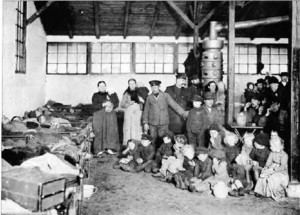
Other Lietuvininkai engaged in commerce, pursued trades, transported goods across all of Texas and into Mexico, which was dangerous work. The first immigrant families were large, as was usual at that time, with 12-14 children. They endured great hardship, poverty, and were no strangers to hard work. Some of the women were servants to the wealthy, taking care of their children as well as their homes and property. Documents show that the first generation married within their own ethnic group, but, as time went on, they intermarried with the Germans, who were far more numerous, especially in the New Braunfels area. We had the privilege of hearing more accounts and seeing more artifacts and documents at a special gathering organized for us at the Yorktown Historical Museum.
* * *
Recorded and living history in the museums of Yorktown, San Antonio, and New Braunfels.
An afternoon event organized for our benefit took place at the Yorktown Historical Museum. Undoubtedly, the idea for this reception came from the dynamic Patsy Hand, who was helped by Beverly Kerlik (Kirlicks) and a whole group of people with an interest in their roots. The gathering comprised around 60 people, some of them from San Antonio and Austin, and included Yorktown’s mayor Rene Hernandez, as well as descendants of Lietuvininkai from the area, together with journalists and members of the De W itt County Historical Society. This was a rare opportunity for all to meet us and to ask questions about our plans and about the joint project with Lithuania that was the purpose of our visit. After the brief formal portion of the program with official greetings and introductions, we got together in smaller more casual groups. People had brought their family records, letters, photographs, artifacts, maps, and bulging folders with the results of their genealogical research. We felt caught up in a whirlwind of histories, accounts, and questions, as if we were on the popular PBS television program “Antiques Roadshow,” where people bring in their valuable old objects to have antiques experts unravel their mysteries and appraise them.
It was here that we met with the fourth and fifth generation descendants. They had brought display stands and documents, where we saw unfamiliar new last names together with those we had seen in the cemeteries: Stanchos, Kirlicks, Mertine, Praetz, Lundschen, Raguzus, Jonischkies, Gelszus, Lempke, Lenkeit, Junker, Guddatis, Mosteit, Gutzas, Jutzas, Jankus, Weichies, Weischvill. It was so marvelous to watch their faces and to hear them talk about their ancestors! We listened to and videotaped the personal oral histories of various families. The Stanchos (Standus) family’s greatgrandchildren take pride in having preserved over 150 years some articles that their great-grandparents had brought with them: original fishing nets and a spinning wheel from Lithuania Minor, which are now considered museum pieces. Others came with original letters written in Lithuanian using German gothic script. From them we learned of the day-to-day lives of the immigrants, the concerns of the farmers, the family news they shared, the well wishes and holiday greetings they exchanged, and the longing they expressed for close ones and families left behind.
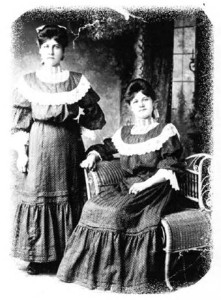
We happily leafed through several old Lithuanian books – a prayer book and a book of lessons for a Christian life that someone had brought in. People were so surprised that we could read the Lithuanian texts with ease and translate them into English. Among the more interesting artifacts we saw were early photographic equipment, work tools, textiles, rare glass and pottery.
We felt the emotion of the participants as they recounted the hardships endured by their ancestors on their journey to the promised land. Their eyes filled with tears, as they spoke of the exhausting and dangerous trek and the challenges of the rugged land that their great-great-grandparents had to overcome in order to reach their goal. European emigrants sailed into New Orleans and Galveston on tall ships and, after clearing customs and immigration, they boarded smaller vessels to sail as far west as they could, heading to the port of Indianola (originally known as Carlshafen), which had been established not long before, in 1846, by Germans. This route allowed the immigrants to avoid many of the rivers that flowed into the Gulf of Mexico and the arduous crossings, since there were no bridges or ferries. The “Indianola Trail” began here and took most of our countrymen into the interior. Indianola was destroyed during the hurricane of 1886 and today is only a ghost town with a few remaining structures and some historical markers standing in the bare, swampy plains. Once they debarked at their final port, the settlers traveled on to their destinations mostly on foot, wading through swamps and swift streams, trying to avoid confrontations with the native inhabitants, the warlike Comanches. The women had to walk and carry a load just like the men and suffered all the deprivations that came with settling there and surviving. The conditions the immigrant pioneers faced were never easy, but these Lietuvininkai prevailed over the many trials that tested them and successfully established themselves in the new land.
Columnist Henry Wolff, Jr. of the daily Victoria Advocate reflected that it would be fascinating to be a bystander on Victoria’s main street during that time and to observe the motley mass of people going by, often dressed in their native costumes or in homespun clothes, carrying their modest belongings; to see two-wheeled carts pulled by oxen; to watch the frontier guides, traders, soldiers, and all sorts of fortune seekers in this migration of nations to the New Land of Texas. Victoria was founded at the major crossroads of South Texas and through it passed a constant stream of new immigrants. W hat a fantastic visual scene it would be, if one could recreate and film the progress of this first wave of emigrants from Europe to Texas in the middle of the 19th century, similar to those documentaries we watch about the strategic battles and military campaigns of past wars and about other important moments in history!
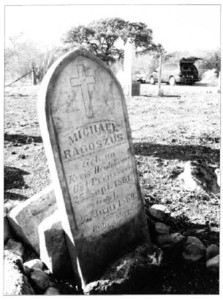
Also at this gathering was Thomas Shelton, museum curator at the Institute of Texan Cultures (ITC) at the University of Texas, San Antonio. We had the opportunity to meet him and to see the Lithuanian display in the museum ’s library at the beginning of our trip. Patsy Hand is in regular contact with this interesting man and has hopes of expanding the Lithuanian display in the future with additional artifacts and with documentary footage of individuals sharing oral histories and personal accounts. At the museum itself you can find entertaining interactive exhibits that represent more than twenty ethnic and cultural groups. The Germans, Swedes, Danes, Czechs, Poles, Lebanese, Greeks, Chinese and many other nationalities can take pride in attractive informative displays. You can also listen to recordings of their music, their spoken language, and their oral histories. As an interesting note, the Wends (a Slavic people also known as Sorbs who live in eastern Germany) have a sizeable exhibit, even though they never possessed or established their own political state. One can hope that with time the Lietuvininkai of Texas also will have a larger exhibit space there.
Located between San Antonio and Yorktown is New Braunfels, another city important in history. Starting in 1845, it was the staging area for the journey inland by emigrants organized by German noblemen. One of the earliest groups was led by Prince Carl Solms-Braunfels, who lent his name to that place as well as to the port of Carlshafen-Indianola mentioned earlier. New Braunfels has a wonderful museum of history that houses a captivating exhibition depicting the town’s mid-19th century life with authentically recreated stores, trades shops, businesses of all sorts, a pharmacy, a doctor’s office, places of worship, school rooms, musical instruments. In one section there are filmed oral histories projected onto a screen or on computer monitors. Settling and farming alongside the Germans of New Braunfels were the area’s first Lithuanian immigrants. Preserved in the museum’s collections are artifacts used in their daily lives and handicrafts made by the women. The museum’s archives contain thousands of personal and public documents, which can be accessed for a fee.
I could not help but feel that the people of Texas have a genuine interest in their ancestors and have enormous respect for their courage, perseverance, and spirituality. They have preserved their traditions and cultural legacy with great care and lovingly pass down their rich heritage to future generations.
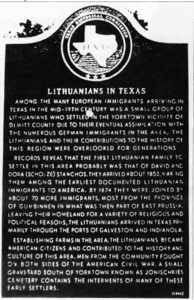
On this journey to Texas with my fellow Bostonians, I was prepared to see farms, crumbling buildings, old photographs, and to meet with a few descendants still interested in such things. It turns out that I had set my expectations far too low, because I cannot possibly capture in this one article the whole gamut of sights and emotions that I experienced during those five days.
We came away from our journey with deeper, stronger insights and with a desire to reexamine, with renewed pride, those treasured values we carry within us: the love of our homeland, our language and culture, our roots and ancestors. We hope that our input, as part of a joint effort with the museum staff in Lithuania, will contribute to a comprehensive visual historical exhibit with a catalogue and a documentary film about mid-19th century Lithuania Minor. Furthermore, we would be very gratified, if this led ultimately to new studies of the geopolitical, social, and religious causes, as well as the living conditions, that spurred these people to emigrate to the New World in order to seek freedom, land, and new sources of livelihood for themselves and their children.
At our gathering in Yorktown, someone suggested that Texans should go as a group to the opening of “The First Lithuanians in Texas” exhibit in Klaipėda in 2009. Many who were there greeted the idea with enthusiasm. Let us hope that the exhibit does become a reality.
 DRAUGAS NEWS Lithuanian World Wide News in English
DRAUGAS NEWS Lithuanian World Wide News in English
